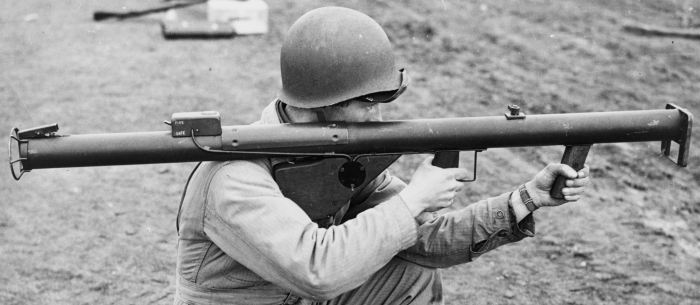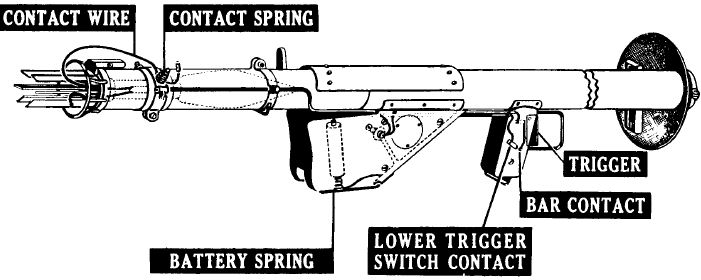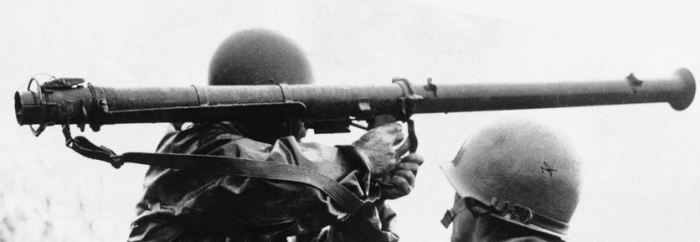
US soldier aiming M1 Bazooka rocket launcher

M1 Bazooka rocket launcher diagram

M9 Bazooka rocket launcher

US soldier aiming M9A1 Bazooka rocket launcher
The M1 anti-tank rocket launcher came into existence in 1942 as an extended range delivery system for new shaped charge anti-tank grenade, developed by US Army. The new hand grenade was effective against current German tanks but was heavy, and its throwing range was dangerously short. Therefore, US Army Lt. Uhl added a small rocket motor to the rear end of the shaped charge AT warhead, and designed a simple tubular launcher to project it with reasonable degree of accuracy. The new AT rocked was officially designated as “Rocket, A.T., M6, 2,36 inch”, and the launcher was designated as “2.36-inch Anti-Tank Rocket launcher M1”. Both were adopted in mid-1942, and by late 1942, a simplified M1A1 launcher was adopted and put into production. The hastily developed M1 rocket launcher and M6 rocket had several serious reliability and safety issues, and by late 1943 US army adopted an improved M6A3 AT rocket and a new M9 rocket launcher. The popular nickname “Bazooka” came from similarity of the launcher tube to the tubular musical instrument of the same name invented and popularized in the 1930s by US comedian Bob Burns.
First operational use of the M1 anti tank rocket launcher by US troops was recorded late in 1942, in Northern Africa. Later M1 and M9 “Bazooka” AT rocket launchers were widely used in both European and Pacific theaters of operation, against enemy armor, field entrenchments and light fortifications, bunkers etc. By the end of the WW2 60mm rockets were considered to be insufficiently effective against most modern medium and heavy tanks, but US troops viewed them as useful light support weapons. M9 bazooka rocket launchers last saw extensive use by US forces during Korean war, but were found to be ineffective against Soviet-made T34 medium tanks.
The historical importance of M1 Bazooka anti tank rocket launcher is that it was the first practical weapon of its type, spurring similar developments first in Germany and then in many other nations.
Normal crew for the M1 and M9 Bazooka anti tank rocket launchers consisted of two men – shooter / operator and loader.
The M6 Anti-Tank rocket was powered by a solid fuel motor which normally burned completely within the launcher tube. Its muzzle velocity was about 80 m/s (265 fps). Rocket motor had electrical ignition system which was constant source of reliability issues, especially in cold or wet climates. Shaped Charge warhead contained about 720 gram (1,6 Lb) of high explosive, and was capable to defeat up to 9-10 cm (3.5” – 4”) of steel armor. It was stabilized in flight by six fixed tail fins. The M6A3 rocket had improved warhead shape and fins supplemented by cylindrical tail. When fired, the rocket motor creates dangerous backblast zone behind the launcher with maximum depth about 15 meters from the rear end of the launcher. Another one widely issued type of rocket for M1 and M9 bazooka launchers was M7 (M7A1 and M7A3) practice round with inert warhead.
The M1 Bazooka anti tank rocket launcher was built around the steel launching tube (smoothbore barrel), opened at both ends. Rockets were loaded into the barrel from the rear. After loading, rocket had to be connected to the electric firing system by its own wire, which is attached to the contact spring next to the rear end of the barrel. Bazooka rocket launcher was fitted with wooden shoulder stock that has compartments for four D-cell dry batteries – two to power rocket ignition system and two spares. Small signal lamp was fitted to the side of the shoulder stock to test the launching circuit. The pistol grip had simple trigger which closed the ignition circuit when pulled, and weapon initially lacked any manual safeties
Source: ModerfireArms.net
No comments:
Post a Comment